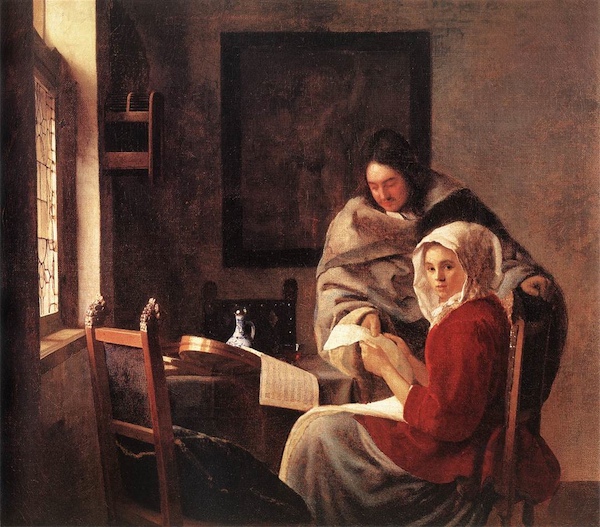
Ach liebste laß vns eilen
Wir haben Zeit:
Es schadet das verweilen
Uns beyderseit.
Der Edlen schönheit Gaben
Fliehn fuß für fuß:
Daß alles was wir haben
Verschwinden muß.
Der Wangen Ziehr verbleichet
Das Haar wird greiß,
Der Augen Fewer weichet,
Die Brunst wird Eiß.
Das Mündlein von Corallen
Wird vngestalt,
Die Händ’ als Schnee verfallen,
Und du wirst alt.
Drumb laß vns jetzt genießen
Der Jugend Frucht,
Eh’ als wir folgen müssen
Der Jahre Flucht.
Wo du dich selber liebest,
So liebe mich,
Gieb mir das wann du giebest
Verlier auch ich.
Oh, beloved, let us make haste,
We have time,
But to tarry will injure
Both of us.
The noble gifts of beauty
Flee step by step,
And everything we have
Must pass away.
The ornament of your cheeks pale,
Your hair turns gray,
The fire of your eyes passes,
Your chest turns to ice.
Your little lips of coral
lose their shape,
Your hands melt away like snow,
As you grow old.
So let us now enjoy
Youth’s bounty,
Before we follow
With the flight of the years.
As you would love yourself,
So love me.
Give to me, so that when you give,
I will share your loss.
—Martin Opitz, Ode VIII: Ach liebste laß vns eilen from Oden und Gesänge (1618)(S.H. transl.)
“Ach liebste laß vns eilen” by Martin Opitz is a simple but quite beautiful love poem in the Silesian baroque style. It proceeds from the typical notion of carpe diem, the need to seize the moment of life before it passes, presented in this case as a request to the poet’s beloved, repeated several times over the 24 lines of the poem. The 24 lines can, however, be read in the form of classical Latin poetry as 12 lines, each interrupted with a cæsura or pause (as incorporated in the Nauwach setting below). The first word “ach” is more an exclamation or suggestion of worry, and it sets a tone from the outset of the effort to grasp time. It has a simple cadence that drives the work forward and makes it ultimately an easy poem to set as a song. The poet pursues this narrative using three pronouns—the narrative I, the intimate you, and the conjoined we.
The work is divided into three stanzas. The first stanza consists of an appeal to the poet’s love interest not to allow time to pass without the fulfillment of their love, because “everything” (that is, also love) fades with time. In the second stanza, beauty is itself described as the object of the powers of transformation. The physical aspects of the beloved beauty are catalogued (the fiery eyes, graceful cheeks, the coral-like lips) in a manner that reflects the esthetics of the baroque era. Consider a massive, flesh-filled painting of a master like Rubens, and you will always see prominent coloration given to lips and cheeks—much as this poem suggests, and even in the more restrained and intensely domestic settings of a master like Vermeer, as shown in his Girl Interrupted at Her Music, where the ruddy cheeks and lips are highlighted by a matching blouse. But these tokens of feminine beauty are transitory, they grow pale (verbleichen), turn soft (weichen) and finally expire (verfallen).
This sets the stage for the third stanza, beginning with the word “drumb” (wherefore), in which the poet refers to the “fruit of youth” and proposes that it be enjoyed. Youth is viewed as the age for love, beauty and sensual delights. Age marks the approach of death and the extinguishment of these earthly pleasures. The poem is a font of baroque esthetics and values, simply conceived and well executed.
The song has been taken from Johann Nauwach’s Teutsche Villanellen (1627). It is a perfect example of the Italian continuo song transformed to fit German circumstances.
Listen to a performance of the work by Andreas Scholl:



